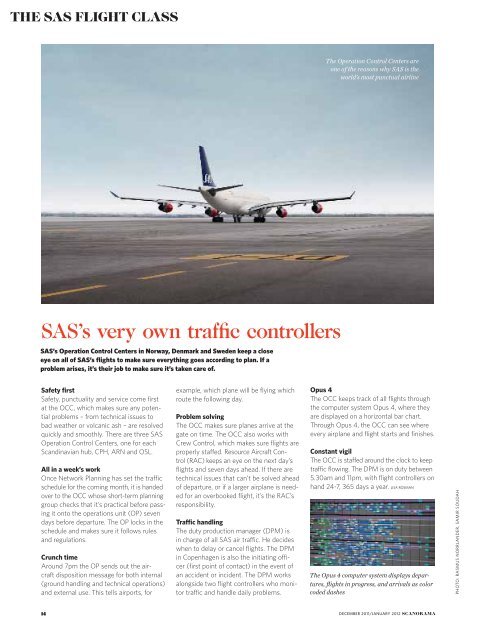Old school New England 92 - Scanorama
Old school New England 92 - Scanorama
Old school New England 92 - Scanorama
Create successful ePaper yourself
Turn your PDF publications into a flip-book with our unique Google optimized e-Paper software.
HEAD THE SAS FLIGHT CLASS<br />
SAS’s very own traffi c controllers<br />
SAS’s Operation Control Centers in Norway, Denmark and Sweden keep a close<br />
eye on all of SAS’s fl ights to make sure everything goes according to plan. If a<br />
problem arises, it’s their job to make sure it’s taken care of.<br />
Safety fi rst<br />
Safety, punctuality and service come fi rst<br />
at the OCC, which makes sure any potential<br />
problems – from technical issues to<br />
bad weather or volcanic ash – are resolved<br />
quickly and smoothly. There are three SAS<br />
Operation Control Centers, one for each<br />
Scandinavian hub, CPH, ARN and OSL.<br />
All in a week’s work<br />
Once Network Planning has set the traffi c<br />
schedule for the coming month, it is handed<br />
over to the OCC whose short-term planning<br />
group checks that it’s practical before passing<br />
it onto the operations unit (OP) seven<br />
days before departure. The OP locks in the<br />
schedule and makes sure it follows rules<br />
and regulations.<br />
Crunch time<br />
Around 7pm the OP sends out the aircraft<br />
disposition message for both internal<br />
(ground handling and technical operations)<br />
and external use. This tells airports, for<br />
example, which plane will be fl ying which<br />
route the following day.<br />
Problem solving<br />
The OCC makes sure planes arrive at the<br />
gate on time. The OCC also works with<br />
Crew Control, which makes sure fl ights are<br />
properly staff ed. Resource Aircraft Control<br />
(RAC) keeps an eye on the next day’s<br />
fl ights and seven days ahead. If there are<br />
technical issues that can’t be solved ahead<br />
of departure, or if a larger airplane is needed<br />
for an overbooked fl ight, it’s the RAC’s<br />
responsibility.<br />
Traffi c handling<br />
The duty production manager (DPM) is<br />
in charge of all SAS air traffi c. He decides<br />
when to delay or cancel fl ights. The DPM<br />
in Copenhagen is also the initiating offi -<br />
cer (fi rst point of contact) in the event of<br />
an accident or incident. The DPM works<br />
alongside two fl ight controllers who monitor<br />
traffi c and handle daily problems.<br />
The Operation Control Centers are<br />
one of the reasons why SAS is the<br />
world’s most punctual airline<br />
Opus 4<br />
The OCC keeps track of all fl ights through<br />
the computer system Opus 4, where they<br />
are displayed on a horizontal bar chart.<br />
Through Opus 4, the OCC can see where<br />
every airplane and fl ight starts and fi nishes.<br />
Constant vigil<br />
The OCC is staff ed around the clock to keep<br />
traffi c fl owing. The DPM is on duty between<br />
5.30am and 11pm, with fl ight controllers on<br />
hand 24-7, 365 days a year. LISA ROSMAN<br />
The Opus 4 computer system displays departures,<br />
fl ights in progress, and arrivals as color<br />
coded dashes<br />
14<br />
PHOTO CAMILLA DECEMBER LINDQVIST 2011/JANUARY // SCANORAMA 2012 SCANORAMA<br />
APRIL 2011<br />
PHOTO: RASMUS NORRLANDER, SAMIR SOUDAH












